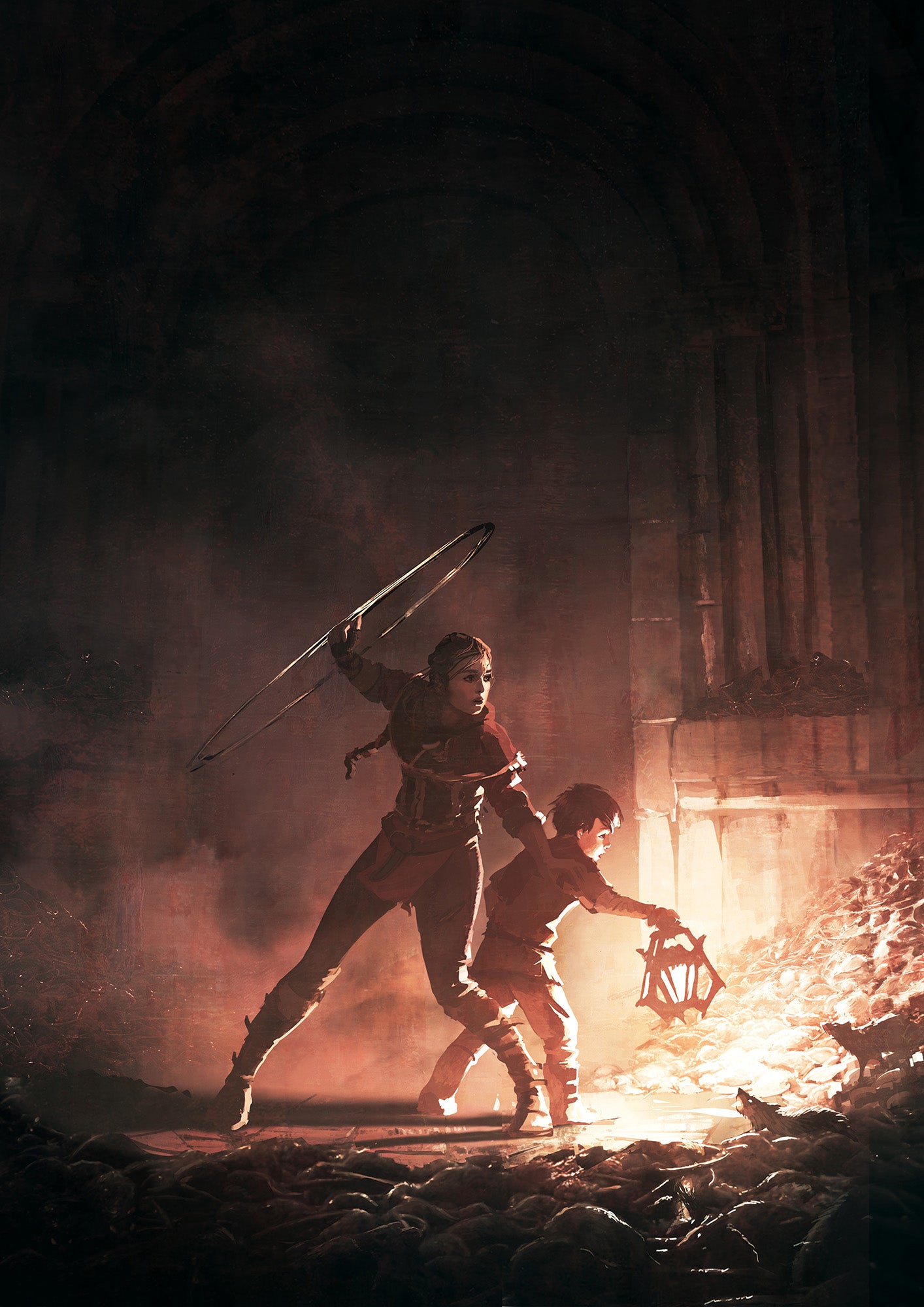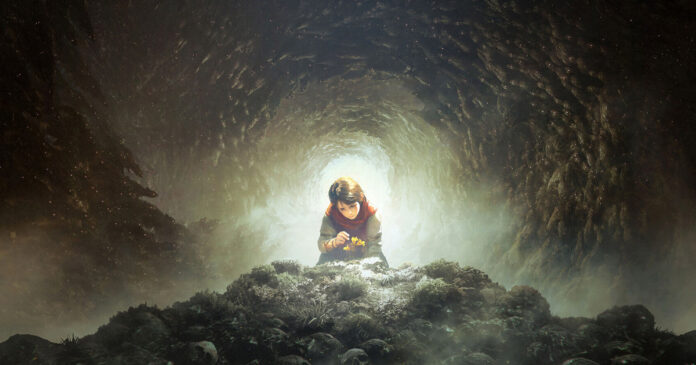Sometimes it’s hard to imagine, when a game becomes a series and an admired one at that, that once upon a time there was nothing. There was nothing tangible. All there were, were hopes and ideas, swirling around. And the process of materialising them into something: it’s a fragile thing. There’s no certainty that what will come out the other end will even survive that process. And A Plague Tale: Innocence, it turns out, very nearly didn’t.
For one dread-filled moment near the end of the originally-allotted development time, the Plague Tale project nearly failed. French studio Asobo suffered a sucker-punch of a setback that meant the game, and any aspirations of making story-led games like this in the future, was in serious jeopardy. It’s a moment series director Kevin Choteau understandably doesn’t like to recollect.
“I will speak about something that I don’t like to talk [about] normally…” he tells me.
The game was two years into development and external reviewers had been brought in to review where the game was at – a very normal process. Some people call them mock reviews but there’s nothing fake about the feedback they give. And these reviews did not hold back.
“The game was a mess,” Choteau says. “It was awful in terms of gameplay, of story, of everything – nothing was holding together, nothing was quite right […] And it was a huge punch in our face.” It was as if Asobo was being told, “You know nothing, guys. What have you started? You cannot assume that! You don’t know how to do those kinds of games.” And worst of all, the game’s predicted review score was 55-to-60 percent, which, well, as Choteau says, “You don’t want to release that.”
Equally low was the team’s morale. “The team was quite destroyed by this fake review,” he says. So, as the leader of the team, he made the decision to do something drastic.
“We’ve done I think the most dangerous thing that we could do: we stopped everything. We stopped everything – development, polish, debug, everything. And we took a step back – everyone took a step back. I asked everyone in the team to play the game, fully, and to think about what is good, what is not working. And we’ve redone everything that we’ve pointed out.”
What was redone was nothing short of everything. “At least, I would say, one third of every chapter has been changed – it’s the least we’ve done. But for some of them, like three or four […] have been completely redone because it was a mess. We’ve rewritten every dialogue, we’ve reworked the gameplay, we’ve added the selection wheel […] we’ve added some features […] Everything! It was like we were even before Alpha; we renamed all our milestones and went back to pre-alpha and restarted from there.”
But Asobo had to. To not do it would have been to give up on the dream of making its own stories, and to go back to being a work-for-hire team. “It was our first baby and we wanted to be proud of it. We wanted to show to the player, to everyone, who we are as Asobo as a creative team, and failing was not really an option.” So with publisher Focus’ blessing, another nine months was granted, and on 14th May 2019, A Plague Tale: Innocence was released.
Strangely enough, the Plague Tale story begins with HoloLens, the Microsoft augmented reality glasses which flirted with gaming but never really landed here. We tried them once, back in 2015, but these days they’re more of a business thing. And back then, Asobo was one of the studios tasked with imagining what HoloLens gaming experiences could look like. “We’ve done a game that nobody knows and nobody will ever play,” Choteau says with a smile. “It’s called Fragments.”
Fragments was a detective game where you investigated tragic events by talking to characters – who looked life-sized to you with the HoloLens glasses on – and searched for holographic clues placed around actual, real-life environments.
Fragments was a rousing example of the possibilities of HoloLens, but what really excited the team about it was making a game and story of its own. Up until that point, it had been making Kinect and Pixar games. And Fragments awakened something inside Asobo: a desire to do more.
At the same time, The Last of Us landed and it had a profound impact on the Asobo team. The tone, the maturity, the morality: it all spoke to the people working there. “We talked about this game for months and months and months,” Choteau says. And combined with a desire to do more original work, it created the perfect environment for A Plague Tale to be born.
The original idea, from the very beginning, was to tell a story of a harsh world through the eyes of a child. A fair few of the Asobo team were already parents and loved the way children saw the world. “Children are sometimes super naïve […] but they always speak truth,” Choteau says, “they always reveal something about the world that is true and as an adult we cannot see any more.”
The team also loved games like Brothers: A Tale of Two Sons, and ICO, and the idea of taking care of someone more vulnerable than you are as the player, so from day one, the idea of an older girl protecting a younger child was there.
Asobo also knew the younger child would have powers, but what those powers would be, it didn’t know. Rats weren’t yet part of the discussion. The team didn’t know when or where it wanted to set the game.
It knew it wanted some fantasy, because there were supernatural powers in the game, and for a moment, it considered creating an original world to house all of these things in. But this was the studio’s first game, and not only was it “frightened”, as Choteau says, by the prospect of the work involved in doing that, it also didn’t want to pull the attention – both ours and the team’s – away from what it really felt was important about the game: the characters. So it decided to base it in the real world and, because of the studio’s location and knowledge, in France.
But when? This was when the history books came out. Asobo knew it wanted a brutal time period to contrast with the children’s vulnerability, but it also wanted one that people didn’t know so well. “Sadly,” Choteau says, “the human history is full of horrible periods and fighting […] Of course, the French Revolution was something quite hard also, and they were exposed to things, but in terms of culture, beliefs, it was too late for us.”
Then, it flipped open the page on the the Black Death, the most fatal pandemic in human history. “What we loved about the 14th century, when the Black Plague arrived, [is that] people didn’t know anything about it. And there’s lots of beliefs, local stories, about what they were thinking was happening, and it creates tons and tons of small facts that we can use for the game. So it was already very full of things to explore, to expose to the player, so it [as a setting] arrived quite fast. And it was not super-common in video games and even in books or movies – there is not that much story about this era so it was quite good for us.”
Still, though, the rats – as part of the game idea – weren’t there. Asobo knew it wanted to show the plague but the original idea was to depict it in more fantastical ways, in miasma clouds or floating things the player would shoot with Amicia’s sling and destroy – the sling was always part of the pitch, for some reason (“I don’t know why actually”). These miasmas would have weak points that you shot with fire, because alchemy was another idea the team knew it wanted from the beginning, and it all seemed very video gamey, and generic – and the team hated it. “It’s one of those game design ideas that seems super evident and obvious when you are thinking about it, and then you try it and you’re like, ‘No – no, we are destroying everything.'”
It was creative director David Dedeine who eventually hit upon the idea of rats as embodying the plague in the game – a motif, a feature, that would become synonymous with A Plague Tale ever after. “The most common thing about the Black Plague [sic] is the rats,” Choteau remembers Dedeine saying. “Everyone knows that. Everyone thinks that the rats were the origin of the disease and the spreading of the disease. It’s something that we should use.”
And the moment Asobo did use rats, everything fell into place. Here was a stealth game where you couldn’t easily hide in the dark because another threat lay there. Here was a stealth game with light and dark systems. Here was a game with an iconic setting and a point of difference. So, barring some insults from the developers who had to realise hundreds of rats on screen at one time, work on ‘Plague’, as the game was codenamed, got underway.
The incident with the internal review had shaken the team. No one knew if the game was any good any more, and if what they’d remade had affected anything. “We were absolutely lost, actually,” Choteau says.
There wasn’t time to bring people in to do another internal review, so the first time Asobo got outside feedback on A Plague Tale was a month or two before release when press previewed the game. The 40-person team all bundled into the same open space to read the feedback and were cautiously optimistic about what they read. “Huh! Maybe there’s something that delights there,” they thought. “Huh! Maybe it’s working?” It motivated the team for the final push.
“And when the reviews started coming out,” Choteau adds, “we were all together again, many of us around my computer, and we were like…” He pauses. “It was stunning for us. We don’t have a 90 Metacritic, we are around 82, and it was unexpected – the best score we’ve done with Asobo […] We were stunned. I don’t know what to say. I didn’t sleep at all during that night just waiting for the next review and watching streamers playing the game.”
More importantly for Asobo, this represented a starting point. This team had now proven it could make an original game and story of its own, and an audience was building around A Plague Tale. The response was positive. So as the summer months stretched on, and people began to return from holiday and time off, talk turned inevitably to a sequel.
To be clear: there were no plans for a sequel before A Plague Tale: Innocence came out. “Since we were failing doing our game, nobody was thinking that maybe we will do a second one,” Choteau points out.
But the ideas for a sequel had always been there. “We knew that we had ideas in our mind because the end of Innocence is not closed at all. We’ve done that on purpose, saying that maybe someday we’ll be lucky enough to explore what happened next.” And as the months rolled on, the decision became clear. “It was obvious for us that we had to do a sequel,” he says, “we had to showcase the next step and do everything we had in our mind.”
In September 2019, work on A Plague Tale 2 began. And the starting point for it was to address all the things that hadn’t worked, or that people didn’t like, in the original game. “We knew we wanted to do a nice sequel, not a lazy one,” Choteau says. So he asked his team to gather all the negative feedback and find out what the most common things were that people didn’t like. And unsurprisingly, what a lot of people didn’t like was how linear the game was and, how, as he puts it, “you have one way to solve a situation, and if [Amicia doesn’t] do that, you die instantaneously and you can die 20 times without understanding what you have to do”. I’m sure any of you who have played A Plague Tale: Innocence can definitely relate to that.
Opening out the sequel and offering people multiple ways through levels became the starting point, then, and everything changed from there. Not for the first time, Asobo had to redo everything.

The tricky part of Requiem’s development revolved around the climax in the game, which I’m now going to talk about in detail so there will be spoilers ahead.
Here it is again, in big and bold: THERE ARE SPOILERS AHEAD.
The ending was decided, surprisingly, way back during the writing of Innocence. That means, because writing usually happens before production, it was decided as long ago as 2017, if not earlier.
“It has been decided when we were writing Innocence,” Choteau says. “We wrote all the background around the Macula and the rats and everything – the purpose of Gaia, of a Protector. Everything was written down and every threshold they need to cross was there. And we knew that there’s two ways it can end up for tiny Hugo: one is the Apocalypse, and then you will live through the rats, through this desolation of killing people; or he will die.”
The first outcome wasn’t possible because A Plague Tale is based on historical fact, and no such Apocalypse ever happened, obviously, leaving the only possible outcome as number two. And Asobo already knew it wanted to go that far in the sequel and reach Hugo’s “finish line”, as Choteau puts it, and not stretch the storyline out across a third game – a decision I admire.
“And it was super hard,” he says, “because of course we love this character. Hugo is our tiny brother, our child, and we love him, we deeply love him. This is why he is the best candidate also,” he adds, with a wry smile.
But not everyone on the team was happy about it. “For three years I had people coming to my desk and saying, ‘Are you sure we’re going to kill them – you want to do that? Maybe we can do something else – maybe we can kill Amicia! Maybe we can kill no one…’ He laughs recalling the memory. “No, it’s not a bargain,” he would tell them. “We don’t exchange Amicia for Hugo. Hugo is supposed to die. He will die.”
Deciding it would happen was the easy part; working out how to do it was another matter. The final chapter took the longest work of any section in the game. “We’ve done thousands of versions of this final chapter and the way she will approach him and he will die.” Would he die alone? Would you simply watch? Everything the team tried didn’t feel satisfying or work. “He was always dying but still, the way was not defined until it became obvious for us that she had to do it.”
She, Amicia, would kill her brother Hugo, the person she had fought so passionately to protect across two games, two adventures. More poignantly, she would do it with the weapon – originally the toy given by their father – she had relied on the entire time: the sling. For Asobo, it was perfect. “It’s closing the loop.”
But there were still the actors playing the parts of Amicia and Hugo – Charlotte McBurney and Logan Hannan – to tell, whose performances have become as central to the game as the characters themselves, particularly McBurney’s. And you have to remember that A Plague Tale: Innocence was the first game either of them had recorded, both at a young age – McBurney at 17, and Hannan at nine. Hannan still isn’t anywhere near old enough to legally play the games. Those roles of Amicia and Hugo must mean an awful lot to them.
The day of recording the final sequences came. Choteau laughs when I ask how Hannan reacted. “It was funny for him!” he says. “It’s awful but he was in the booth recording those final lines, when Amicia is there and he says that he loved her and that he’s been happy with her and everything. And the take was good and the mic cut off, and he was laughing. And I said, ‘What happened?’ He said, ‘My mum is watching me. She’s crying, and it’s funny.”
McBurney was the total opposite. “She was destroyed,” Choteau says. “She was in pieces. Not enough tissues in the booth. During this sequence, she was herself, basically, living the death of her little brother.”
He was watching the recording from afar, online, as McBurney was recording at Side studio in London, “And everyone was silent, no sound at all. The voice director at Side was not speaking at all. There’s nothing to say,” he says. “We are just crying together and we wait a minute for it to pass.”
It’s McBurney’s authenticity that makes her performance so special, both in my mind and in Choteau’s. He says he can’t thank her enough for the work she’s done. “She has really carried our story,” he says. “She has changed the way we wrote Amicia because she was able to do everything. It’s why I told her, about Requiem, ‘We were able to push the limits in every direction because we knew that you were able to do it, to convey the right feeling, the right emotion, with the right intensity every time.’ And it’s super-easy to work with her.”
The big difference between Requiem’s release and Innocence’s, three years earlier, was that this time there were expectations. Nobody knew about A Plague Tale before Innocence came out so if the game had been a disaster, it wouldn’t really have mattered, but now there were fans’ expectations to live up to. “They are our fuel,” Choteau says, “we are doing the sequel thanks to them. We don’t want to disappoint them.”
This time, as the review embargo lifted, Choteau was hammering F5 on every website, every score aggregator he could think of, while his PC was linked to a projector for all of the team to see, leading to a rollercoaster of ups and downs as different verdicts landed. “The team was like, ‘Oh! Oh. Oh! Oh,’ he says, and laughs.
But it wasn’t all smiles, because verdicts did vary, and mostly for reasons surrounding the technical performance of the game. It was frustrating for the team.
“Frustrating is the best word,” Choteau says, “because when you’ve done a game and people seem to like it, seem to like the story [and] what you have to offer, and you fail for a technical reason: it’s the worst thing. It’s like falling on the last step of a race: it has no reason to fall at this point, and we have never failed on this topic; we are able to do super-demanding Flight Simulator in the best way possible. We fail for a bad reason. Critics have bad words for legitimate reasons, but bad ones. It was disappointing.”
Why the technical performance was overlooked on some platforms, he genuinely doesn’t seem to know. “I don’t know if we were naïve or too much in the excitement of the release, but we haven’t seen it, actually. We’ve played the game on PS5 here at the office, together and doing our review, and we haven’t seen the performance issue. And I don’t know why, I can’t explain it.
“I think we are quite a bit tired of the rats and this kind of story, this kind of mood, so I don’t know what will come next, actually.”
“But we fight back!” he says with enthusiasm, referring to the patches released for the game that have improved performance – not that they can change the review scores now, he laments.
In general, though, A Plague Tale: Requiem has been a success. “I think it took us six months to have one million players on Innocence; it was two weeks for Requiem,” he says. An enormous part of that was Game Pass, of course, which Requiem was available on from day one. Subscription services like PlayStation Plus and Game Pass were also instrumental in building the audience for A Plague Tale before Requiem launched, by including Innocence in their services.
It all begs the question, naturally, of whether there will now be A Plague Tale 3? “I don’t know,” Choteau says. “I don’t know. We’ve talked [in the game] about what happens next, of course – this is why you have this tiny scene at the end, just to say that it’s a never ending cycle.”
He pauses, thinking of what to say. “I don’t know if the team is ready. I don’t know if we have a good thing to say right now. I think we are quite a bit tired of the rats and this kind of story, this kind of mood, so I don’t know what will come next, actually. And I’m not doing some lies there, I’m just being honest. The team is still in the enjoyment of the release and they are doing some research on technical things to improve our engine, to improve our tech, working on performance even more to see if we can push it even further, and we are discussing, just discussing.”
If there ever is a third game, it would understandably have to be – without Hugo – quite different. Amicia still has a mission she can pursue, but, as Choteau says, “it will change the game and the DNA of the thing because it will be Amicia alone against I don’t know what, protecting I don’t know what”.
“For us, it’s hard to figure out right now,” he adds. “It’s not in the pipe.”
But to bring this back to where it all began, what’s most important about this whole Plague Tale endeavour is now, Asobo has proven what it can do. With a team of 40, and then a team of 70 (the Flight Simulator team is a bigger, separate thing), Asobo’s “artisanal” team, as Choteau calls it, has established that it can create spectacular, original stories that millions of people around the world want to play. Adventures that are on a level with some of the very best out there – the Uncharteds of the world. And that, going all the way back to HoloLens and Fragments, was what it set out to do.
So whether or not it’s A Plague Tale 3 that comes next, rest assured something will. “I’m doing everything to make it not stop, every day,” Choteau says. “[…] We’ve done two games that have been liked by people so we want to continue that, we want to be better, to show more stuff, to challenge ourselves also, pushing the limits even further, pushing the tech even further […] We have many ways to improve, we have many things to showcase again and we want to continue on to that.”
Long may it continue.
www.eurogamer.net







